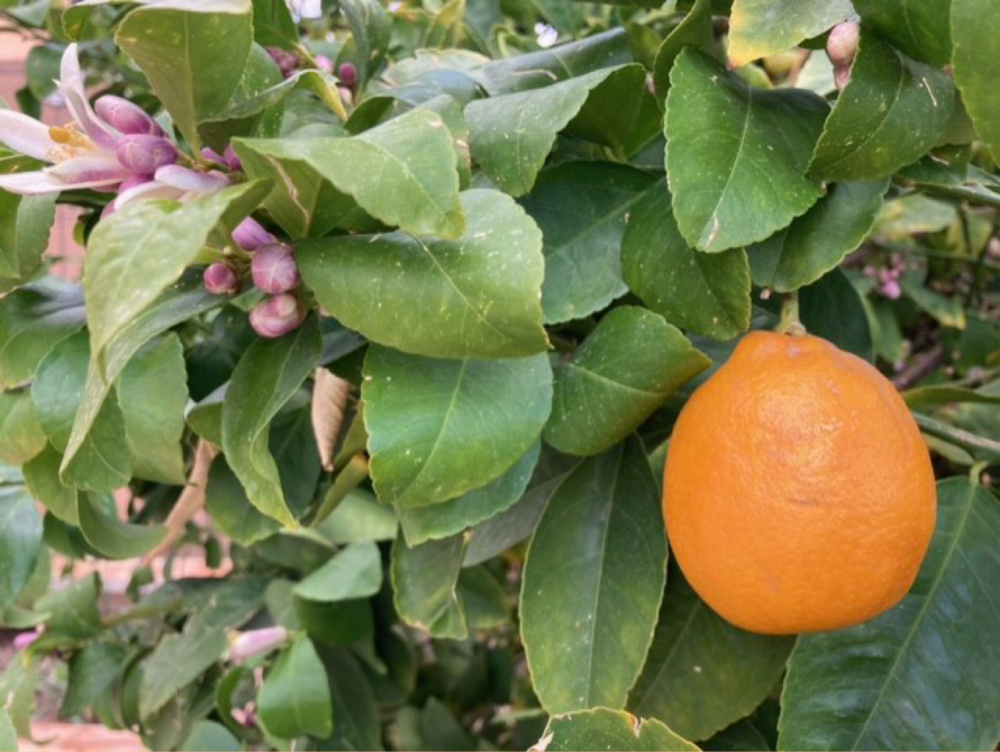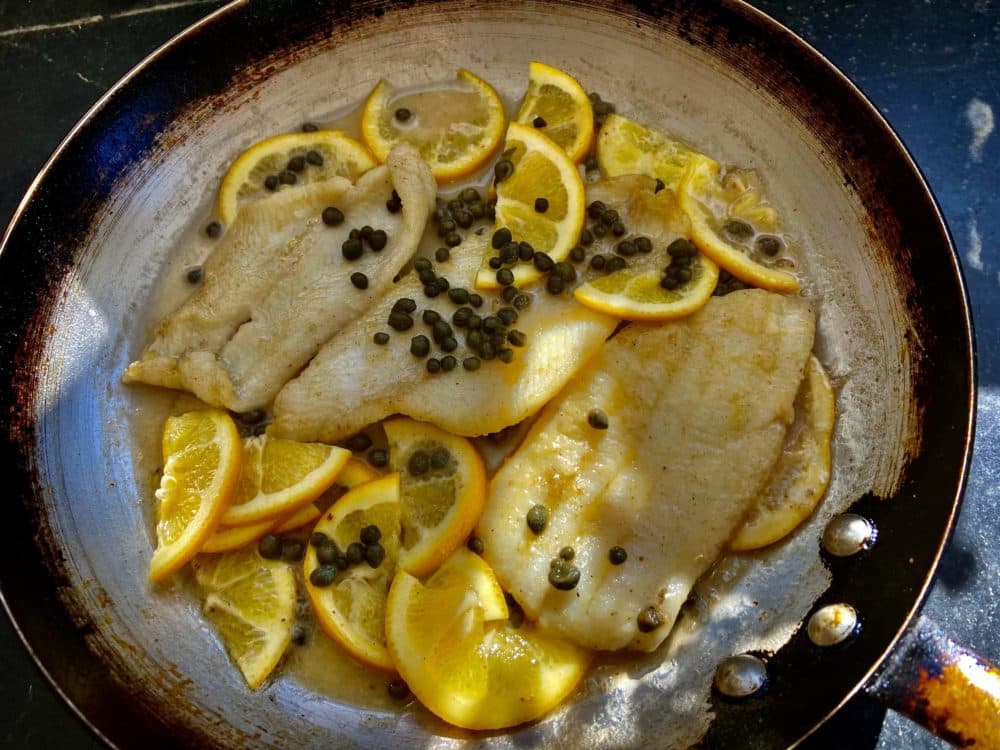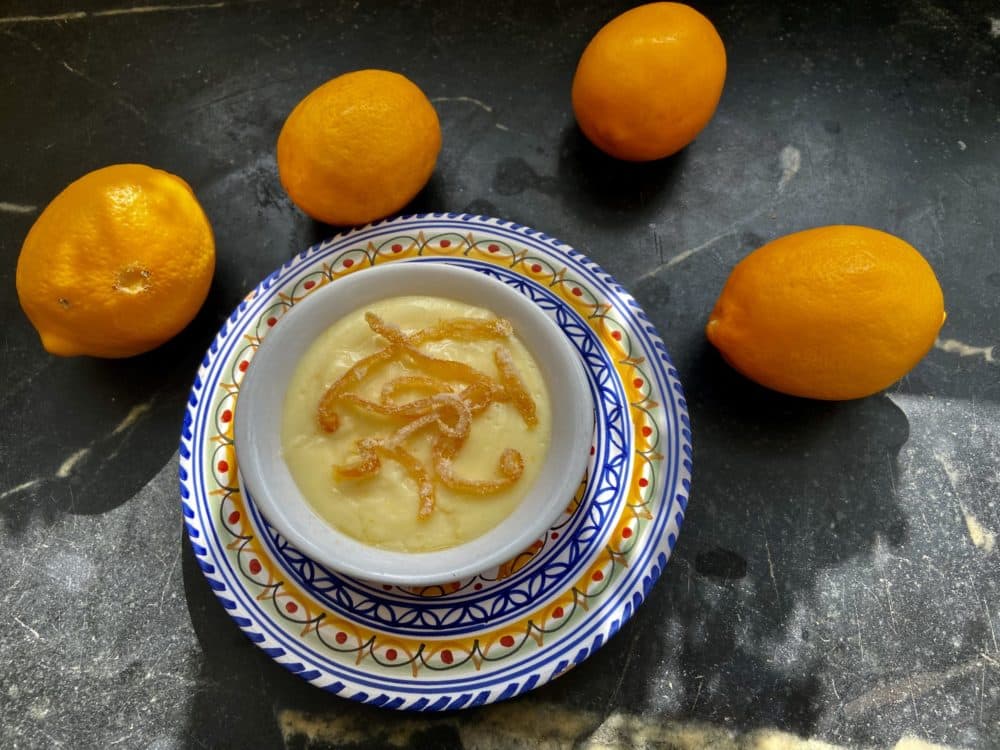Advertisement
Zesty Lemon Recipes That Take The Citrus Beyond Garnish

It’s that in-between season for so many East Coast and Midwesterners. The time of year when it’s no longer the dead of winter, but it’s not spring yet. All the luscious, green spring foods have yet to show up in markets, leaving us in a kind of culinary no man’s land. But still we seek brightness and color after a long winter of soups, stews and many root vegetables.
A solution? Lemons are one of the best ways to wake things up in the kitchen. Bright yellow, with a zesty, sour, tart, bright and acidic flavor, lemons can lift the taste of virtually everything we cook — from soups and sauces to meat and fish dishes to cakes, puddings, marmalade, souffles and pies.
This fruit, so often relegated to the side of the plate or squeezed into hot tea or a cold glass of lemonade, offers so many more possibilities.
Here are a few tidbits about lemon:
- Although they are grown year-round, lemons are considered winter food. The entire fruit can be eaten — the juice used in savory and sweet dishes, and the peel can be candied or zested to add punch to drinks, sauces and cakes.
- You should always wash the outside of the fruit before you zest it to wash away any chemicals the fruit might have been sprayed with.
- Most of the lemons we buy in American grocery stores are Eureka or Lisbon lemons. Meyer lemons, which are like a cross between a lemon and an orange, are in season from November until the beginning of May. They have a thinner, smoother peel than regular lemons and are a yellowish-orange color. The flavor of a Meyer lemon is almost floral, sweet and sour. Meyer lemons tend to be very juicy.
- Lemons are native to Asia.
- A single lemon tree can produce up to 600 pounds of fruit a year.
- Lemons happen to be a great source of Vitamin C (one lemon = over 30 milligrams of vitamin C), calcium, fiber, potassium and zinc. They are also considered an antioxidant that boosts your general health.
- One lemon has about 20 calories.
Fillet Of Sole Piccata

Piccata is an Italian word meaning “to be pounded flat.” This Italian classic is traditionally made with chicken or veal with a lemon, butter and caper sauce. The same technique and flavors can be used with fresh fish fillets.
The combination of paper thin lemon slices, capers and a splash of white wine makes a simple sauce for lightly sauteed fish fillets.
You can use any type of flat fish fillets; I used a delicate fillet of sole with paper-thin slices of lemon (or Meyer lemon), but flounder, mahi-mahi or snapper also works well. The whole dish takes about 20 minutes from start to finish, and is excellent served with orzo, pasta or rice.
Serves 2 to 4, but can easily be doubled.
Ingredients
- About ⅓ cup flour
- Salt and pepper to taste
- 1 pound fillet of sole, flounder, red snapper, mahi-mahi, petrale sole, or other flat fish fillet
- 2 tablespoons olive oil
- 2 ½ tablespoons butter, divided in three pieces
- 1 large lemon or Meyer lemon, washed and sliced paper thin, seeds removed and each slice cut in half
- 1 1/2 tablespoons capers, drained
- ½ cup dry white wine
Instructions
- On a plate mix the flour with a generous pinch of salt and pepper. Lightly dredge the fish fillets in the seasoned flour.
- Preheat the oven to 300 degrees.
- In a large heavy skillet, heat 1 tablespoon of the olive oil and 1 tablespoon of the butter over high heat until the butter is melted and almost sputtering. Add half the fish fillets and cook for 2 to 3 minutes. Gently flip the fish over and cook for another 2 to 3 minutes, depending on the thickness of the fillet; the fish should be golden brown and flake easily. Place the cooked fish on an ovenproof serving plate and keep warm in the oven. Add the remaining tablespoon of olive oil to the skillet and cook the remaining fish. Remove the fish to the plate with the other fillets in the oven; keep warm.
- Over high heat, add half the remaining tablespoon of butter and the lemon slices to the hot skillet and cook for 1 minute. Stir in the capers and then the wine and let boil for 1 minute, or until slightly reduced and thickened. Remove from the heat and add the remaining ½ tablespoon of butter. Spoon the lemon-caper sauce over the fish fillets and serve hot.
Advertisement
Lemon Pudding With Candied Lemon Zest

This is comfort food at its best. Creamy, smooth and bright with the flavor of fresh lemon juice and lemon zest. If you want to up this pudding a notch, make a simple batch of candied lemon zest and sprinkle on top. The pudding can be served at room temperature, but I prefer it chilled. The pudding will keep in the refrigerator for up to three days. The candied lemon zest will keep for several weeks.
Serves 4.
Ingredients
The Lemon Pudding:
- 2 large lemons or Meyer lemons, or 3 small
- ¾ cup sugar (150 grams)
- ¼ cup cornstarch
- 2 ½ cups milk
- 3 egg yolks, lightly beaten
- Pinch salt
- ½ teaspoon vanilla extract
- 2 tablespoons butter, cut into small pieces, at room temperature
The Candied Lemon Zest:
- 1 large lemon or Meyer lemon, or 2 small
- ¾ cup sugar (150 grams)
Instructions
- Make the pudding: Using a microplane or the smallest knob of a cheese grater, grate the lemons making sure to grate only the yellow peel and not the bitter white pith. Set aside. Juice the lemons and set aside; you should have ½ cup.
- Sift the sugar and cornstarch into a medium saucepan. Whisk in the milk, egg yolks, the reserved lemon zest, salt and vanilla extract, and heat over medium-high heat. Whisking frequently, cook the pudding for about 8 to 9 minutes, or until thick enough to coat a spoon. Remove from the heat and stir in the reserved lemon juice and butter and mix until smooth.
- Place the pudding into four 1-cup ramekins or 1 medium bowl. Cover with plastic wrap and refrigerate for several hours and up to 3 days.
- To make the candied lemon zest: Using a wide vegetable peeler, remove strips of each lemon making sure to peel off only the yellow peel and not the bitter white pith. Save the lemons to use for another dish. Place the lemon zest in a small saucepan and cover with water. Bring to a boil over high heat, reduce the heat to a gentle simmer, and cook for 10 minutes. Strain and discard the water.
- Place the zest back into the saucepan with ½ cup of the sugar and ½ cup water and bring to a boil over high heat. Reduce the heat to medium and simmer for 10 minutes. Remove from the heat and, using a slotted spoon, remove the lemon peel strips.
- Meanwhile, place the remaining ¼ cup of the sugar onto a large piece of parchment or wax paper.
- Place the strained lemon strips on the parchment paper with the sugar and roll it in the sugar making sure it adheres to all sides. Remove the candied peel from the sugar, The candied zest will keep in a tightly sealed jar for several weeks. Be sure not to throw out the sweet syrup the zest cooked in; a teaspoon is delicious spooned on top of the pudding, or drizzled on top of pancakes or waffles, or added to drinks.
- Serve the pudding cold or room temperature sprinkled with the candied lemon zest.
Meyer Lemon Pound Cake With Pistachio-Lemon Glaze
Lemon, or preferably Meyer lemon, is used in several ways in this sweet and sour cake: Grated zest is used to flavor the cake, lemon juice is used in the cake and then poured into tiny holes in the cake just after it cools from the oven. A quick glaze — made by simmering thin strips of lemon peel, lemon juice, sugar and chopped salted pistachios nuts — is poured on top of the cooled cake.
The cake will last, covered and refrigerated, for about 5 days.
Serves 6 to 8.

Ingredients
The Lemon Cake:
- 2 large Meyer or regular lemons
- 1 cup sugar (200 grams)
- 2 sticks unsalted butter, at room temperature
- 3 eggs
- 1 3/4 cup all-purpose flour (224 grams)
- 1 1/2 teaspoons baking powder
- 1/2 teaspoon sea salt
- 1/3 cup plus 1 tablespoon milk
- 1/2 teaspoon vanilla extract
The Lemon-Pistachio Glaze
- 1 large Meyer or regular lemon
- 1/3 cup shelled, salted pistachios, chopped or finely chopped*
- 1/3 cup granulated sugar (67 grams)
Instructions
- Generously butter or use canola oil spray to grease a 9 X 4 loaf pan; set aside.
- Make the cake: Preheat the oven to 350 degrees.
- Using a microplane or the smallest knobs on a cheese grater, zest the lemons. Juice one or two of the lemons to get 3 tablespoons of lemon juice; set aside.
- Place the sugar in a small bowl. Add the lemon zest to the sugar and, using your fingers, blend it into the sugar to infuse it with a lemony essence.
- Using a mixer or a hand held mixer, blend the butter until soft. Add the lemon sugar and blend for 4 minutes; the mixture should look creamy and soft. Add the eggs, one at a time, making sure each egg is fully incorporated before adding the next.
- In a bowl whisk together the flour, baking powder and salt.
- Add half the flour mixture to the butter/sugar and mix on low speed until just incorporated. Add the milk and vanilla extract; mix well. Then add the remaining flour mixture and mix just until there are no visible signs of flour in the batter. Spoon the batter into the prepared loaf pan and, using a soft spatula, smooth out the top.
- Place the cake on the middle shelf of the preheated oven and bake for about 50 minutes to 1 hour, turning the pan once about halfway through baking. Bake until a toothpick inserted in the center comes out clean and the center of the cake doesn’t look gooey or moist and the edges are golden brown. Remove from the oven and cool in the pan for 10 minutes.
- After 10 minutes, use a toothpick to poke about 12 holes in the cake. Pour the 3 tablespoons of reserved lemon juice over the cake so it will be absorbed into the holes. Don’t worry if the juice spills out over the sides of the cake into the pan. Let cool completely.
- Meanwhile, make the glaze: Use a wide vegetable peeler, peel off strips of yellow zest off the lemon, being careful not to include the bitter white pith. Once you’ve removed almost all the peel off the lemon cut the peel into thin julienne strips. Juice the lemon and set aside; you should have 3 tablespoons juice.
- In a small pot combine the lemon strips, pistachios, sugar and the 3 tablespoons of lemon juice. Bring to a boil, reduce to low, and simmer for about 3 to 4 minutes or until thickened and bubbling.
- When the cake is fully cooled, remove from the pan. Pour the warm glaze on top and let sit about 10 minutes before serving. Serve at room temperature of wrap in foil and refrigerate for up to 5 days.
Other Favorite Lemon Recipes
- Chicken piccata
- Roast chicken with lemon and herbs
- Lemon pasta (spaghetti al limone)
- Lemon potatoes
- Kebobs with lemon
This segment aired on March 9, 2021.
